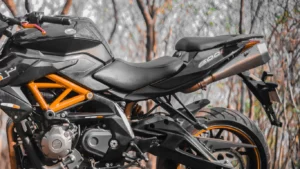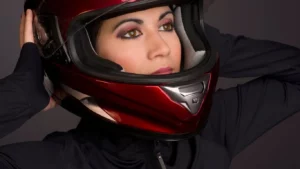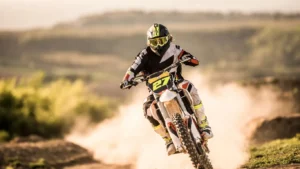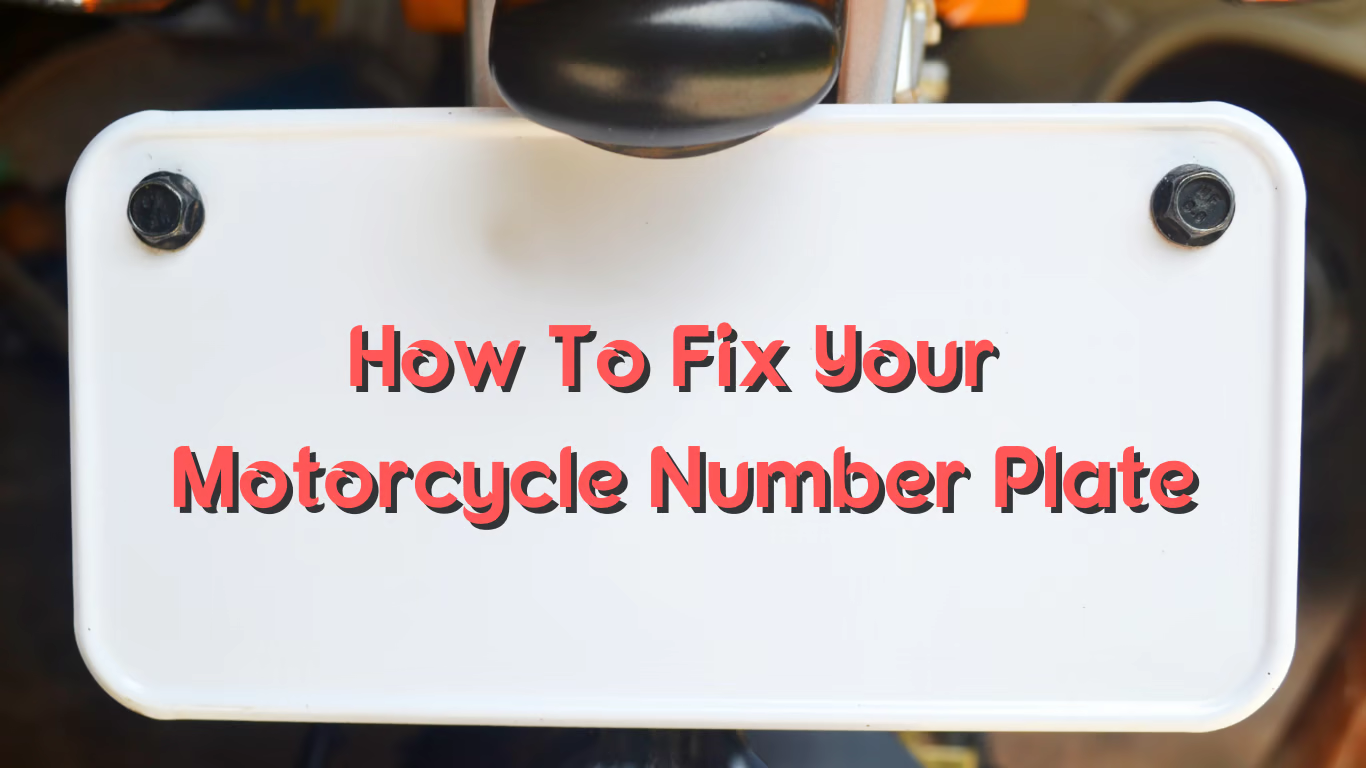A girls’ dirt bike is a dirt bike that is either specifically made for girls or one that a girl chooses to ride. A girl should select a dirt bike that fits her size and level of experience because dirt bikes come in a number of types and sizes. A girl can ride any dirt bike as long as it is the correct size and is safe to ride, although some dirt bikes may be marketed expressly for females and feature smaller frames and lower seat heights. Girls dirt bikes can be used for many different things, including off-road riding, racing, and recreational riding. For girls to reduce the chance of damage, it’s critical to wear the proper protective gear and follow safe riding methods.
Although riding a dirt bike might be exciting, it’s crucial to take the right safety steps to protect yourself. Make sure you have the appropriate equipment before you even get on the dirt bike. This includes a helmet, eye protection, gloves, long pants, and ankle-supporting boots.
Before you begin riding, give the bike some time to become familiar with you. Become comfortable using the clutch, brakes, and throttle by sitting on them. In order to practice riding your dirt bike, locate a level, open space. Keep yourself away from from high hills and dangerous regions until you become skilled.
Start off slowly, controlling your motions with the clutch and brakes. Gradually pick up the pace as you get more at ease. It’s crucial to have your weight evenly distributed over the bike when riding a dirt bike. You can maintain your balance and maintain control by doing this.
You can steer the bike with your legs, especially when turning. To assist you stay balanced, keep your inside foot up and your outer foot down. Your primary focus when riding a dirt bike should always be safety. You can learn how to ride a dirt bike safely and confidently as a female if you have the correct equipment, perseverance, and practice.
Dirt Bike Riding Tips For Women
Here are some important tips for women to know before dirt bike riding.
1. Wear appropriate gear
When riding a dirt bike, it’s essential to wear the right gear.
Here are some protective clothing options to think about wearing:
Helmet:
In the event of a fall or accident, a helmet is absolutely necessary for your head’s protection. Choose a helmet that is both snugly fitting and authorized for off-road use.
Goggles:
Wearing goggles will shield your eyes from flying dirt, rocks, and other debris.
Gloves:
Your hands are shielded from cuts, abrasions, and blisters by gloves. They also improve the handlebars’ grip.
Boots:
Ankle support boots offer protection and aid in preventing ankle problems. Choose boots with a firm sole and excellent traction.
protecting your chest:
Your chest and back are protected from blows and flying objects with a chest protector.
Knee and elbow protectors: Knee and elbow pads help shield wounds and abrasions by cushioning the stress on your joints.
It’s crucial to spend money on sturdy safety equipment that fits well and is comfortable to wear. The risk of damage when riding a dirt bike can be considerably decreased by donning the proper protection.
2. Familiarize yourself with the bike
When learning to ride a dirt bike, becoming familiar with the bike is crucial. You can do the following to get more acquainted with the bike:
Read the instruction manual:
In the owner’s manual, you may find important information about how to ride the bike, how to take care of it, and what safety features it has.
Sit down on the bike:
Get a sense of the bike’s weight and balance by sitting down on it. To fit your body, alter the handlebars, mirrors, and foot pegs.
Discover the controls:
Learn how to use the clutch, brakes, throttle, and gear shifter on the motorcycle. While the bike is still, practice utilizing the controls.
Practice beginning and ending:
Practice kicking the bike into gear and starting it. Practice utilizing the clutch and brakes to stop the bike.
Before you ride, check your bike:
Do a quick check to ensure everything is in working order before riding the bike. Examine the tires, clutch, throttle, and brakes.
When the time comes to start riding, you’ll feel more at ease and confident if you are familiar with the bike. Prior to tackling more difficult terrain, always take your time and practice in a safe, open place.
3. Practice in a safe environment
It’s critical to practice in a secure setting when learning to ride a dirt bike. Here are some pointers for choosing a secure location to train:
Search for a wide, level area:
Choose a level, open spot where you can practice riding a dirt bike. Unless you have more experience, stay away from locations with barriers, high hills, or difficult terrain.
Don’t drive in the traffic:
Practice at a place free from pedestrians, traffic, and other dangers. If at all feasible, pick a place where riding dirt bikes is permitted.
Obtain approval:
Verify that you have the necessary authorization to bike in the chosen area. Get permission from the owner if you plan to practice on someone else’s property.
Bring a friend:
Always ride with a companion who can assist you in case of an emergency or accident. Also, traveling with a friend might be more enjoyable!
Maintain your boundaries:
When practicing, go slowly and within your boundaries. As you gain experience, gradually raise your speed and difficulty.
Never forget to put safety first when riding a dirt bike. Your risk of harm can be decreased and your riding confidence can be increased by practicing in a secure setting.
4. Start slowly
Start out gently when learning to ride a dirt bike.
In order to have more control over the bike, you should begin in a low gear. You can more easily start and stop the bike thanks to this. Start getting comfortable with using the throttle to manage speed. Start out slowly and build up to a faster pace as you get more comfortable.
For regulating the bike’s speed and power, the clutch is crucial. You should know about starting and stopping the dirt bike. Simultaneously, you must learn about changing gears, using the clutch. For regulating the bike’s speed, the brakes are also crucial. Practice stopping the bike and slowing it down with the brakes.
Use your legs to assist in steering the bike while maintaining a balanced weight over it. You’ll maintain your equilibrium and maintain control if you do this. When riding a dirt bike, the ability to turn is crucial. As you gain experience, gradually speed up your turns after starting out slowly.
It is also important to build up your confidence. You will slowly improve your riding abilities and self-assurance with time, practice, and patience.
5. Stay balanced
When riding a dirt bike, balance is key. Avoid leaning too far in front of or behind the bike; keep your weight evenly distributed over the vehicle. You can retain equilibrium and control by doing this.
To assist you in steering the bike, use your legs. Keep your feet firmly planted on the foot pegs and your knees bent.
Instead of looking at the ground or the bike, focus on the direction you want to move in. You can anticipate problems and keep your balance by doing this.
As you cross bumps or uneven ground, adjust your body position. To keep the front wheel up, lean back slightly; to keep the rear wheel down, lean forward slightly.
To assist you keep control and absorb shocks, use your arms. Keep your arms relaxed and your elbows bent.
With a dirt bike, maintaining balance requires experience and practice. Take your time, be patient, and don’t be embarrassed to approach more seasoned riders for assistance or advice.
6. Use your legs to control the bike
Grasp the bike with your knees to help regulate and steady its movements. Keep your feet firmly planted on the foot pegs and your knees bent.
Avoid leaning too far in front of or behind the bike; keep your weight evenly distributed over the vehicle. You can retain equilibrium and control by doing this.
When turning, use your outer foot to help steady the bike. To assist you stay balanced, keep your inside foot up and your outer foot down.
When traveling over uneven ground or bumps, stand up and use your legs to cushion the impact and keep control. Keep your feet firmly planted on the foot pegs and your knees bent.
When making a sharp turn, shift your weight to the inside of the turn. You can keep your composure and equilibrium by doing this.
7. Practice turning
While first learning how to ride a dirt bike, one of the most vital skills to practice is turning. Practice makes perfect, so here are some pointers for turning:
Look ahead:
Instead than looking at the ground or the bike, focus on the destination you want to reach in the future. You will be better able to anticipate problems and keep your balance if you do this.
Move your center of gravity:
While you are making a sharp turn, you should move your weight to the inside of the turn. This will assist you in maintaining your equilibrium and giving you greater control.
Utilize your legs:
Make use of your legs to assist you in maintaining control of the bike. Maintain a knee bend and make sure that both of your feet are firmly placed on the foot pegs.
Engage the parking brake:
During turning, you can regulate the speed of the bike by using the clutch. Getting some practice with the clutch will help you accelerate and decelerate more smoothly during curves.
Begin with a low gear:
At begin, you should turn at a slow speed, and as your experience grows, you should gradually increase the speed at which you turn.
Do drills in both directions:
Turning in either direction requires plenty of practice before you can feel confident doing it in either direction.
Getting experience on a variety of terrains:
To perfect your talents, try practicing your turns on several types of terrain, such as flat ground, slopes, and corners. You will find that practicing this in a variety of riding conditions helps you feel more at ease and gives you increased self-confidence as a consequence of your efforts.
Bear in mind that acquiring the skill of turning on a dirt bike demands a significant amount of experience as well as practice. Be patient and take things at your own pace, and if you feel like you need help or guidance, don’t be afraid to ask more experienced riders for it. Be patient and do things at your own pace.
8. Always wear protective gear
When riding a dirt bike, it is absolutely necessary to wear protective gear at all times. Whenever you go on a ride, you should always make sure to wear the following pieces of safety equipment:
Helmet:
It is important to wear a helmet in order to protect your head in the event of an accident or fall. Choose a head protection that offers a snug fit and is designed for use away from paved roads.
Goggles:
Wearing goggles guards your eyes against dirt, rocks, and other particles of debris that may be kicked up while you are riding.
Gloves:
Wearing gloves will prevent you from getting blisters, cuts, and abrasions on your hands. Moreover, they offer a more secure hold on the handlebars.
Boots:
Boots that give support for the ankle offer protection and can assist in preventing ankle injuries. While shopping for boots, look for ones that have a firm sole and decent traction.
Protector of the chest:
Your chest and back can be protected from potential injuries caused by crashes and flying debris when you wear a chest protector.
Pads for the knees and elbows:
Pads for the knees and elbows not only shield your joints from the force of an impact but also help guard against cuts and scrapes.
It is essential to make a financial investment in well-fitting, high-quality protection gear that is also comfortable to wear. While riding a dirt bike, reducing the likelihood of suffering an accident by using the correct protective gear is possible. Always make sure to put on your protective gear before getting on your bike, even if you’re only going for a practice ride in an empty parking lot.
9. Take a training course
When it comes to learning how to ride a dirt bike, enrolling in a training course is strongly suggested. You will learn proper riding methods, safety recommendations, and it will help you create good habits if you take a training course. You should consider enrolling in a dirt bike training school for the following reasons:
Safety:
Participating in a training course will educate you how to bike safely and lessen the likelihood of you being injured. Important safety tips, as well as strategies for avoiding accidents, will be taught to you.
Appropriate techniques:
You will learn proper riding tactics, such as how to handle the bike, turn, and shift gears, throughout a training course. Your riding ability will improve as a result, as will your confidence in your abilities.
Instill confidence by:
Especially for first-timers, riding a dirt bike can be a nerve-racking experience. A training course can help you develop positive habits and increase your self-confidence.
Discover the ins and outs of maintenance:
You should take a training course to learn how to correctly maintain your dirt bike, as this is crucial for maintaining it in good condition and ensuring that it is safe to ride.
Find and talk to other riders:
Participating in a training course is an excellent way to make new friends who share your enthusiasm for dirt biking. You can gain knowledge from their experiences and establish a network of friends who share similar values.
Keep in mind that taking a training course on a dirt bike will help you become a more confident and safe rider overall. Choose a class that has a good reputation in your area, and don’t be afraid to talk to the teachers there and ask them questions or for guidance.
Conclusion
Riding a dirt bike can be an exciting experience, but you must prioritize safety and take the appropriate precautions. Wearing necessary protective gear, practicing in a safe place, and joining in a training course to get basic riding methods and safety guidelines are all part of this. Dirt bike riding, whether for a woman or a man, can be a fun and fulfilling hobby that delivers a sense of adventure.






